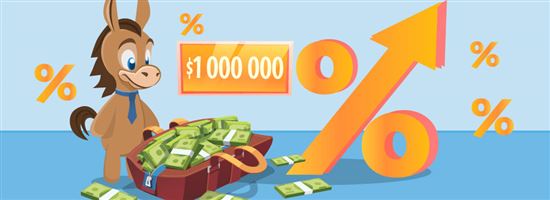How Much Interest Does $1 Million Earn?
Ad Disclosure: This article contains references to products from our partners. We may receive compensation if you apply or shop through links in our content. This compensation may impact how and where products appear on this site. You help support CreditDonkey by using our links.
Can $1,000,000 generate enough interest to live on? This depends on how you save or invest it. Here's how much interest you can earn with a million bucks.
 |
This is probably the goal for many people: reach $1 million, stop working, and live off the interest earnings. But is it enough? Just how much interest does $1 million earn?
It depends on how you save or invest that one million bucks. Here's how much $1,000,000 will earn in one year in different scenarios:
- In a 4% high-yield savings account: $40,000 in interest
- In the stock market:[1] $96,352 in returns
- In real estate:[2] $108,000 in returns
- In a mutual fund:[3] $46,700 in returns
- In a normal savings account:[4] in interest
A wise investment will make your money go further. It seems like the obvious choice to invest in stocks, right? But it also depends on your age, goals, and risk tolerance.
Keep reading for a more in-depth discussion. Plus, the smart way to retire off of $1 million.
Tip: You don't have to be a millionaire to invest money and make passive income.
Real Estate Investment: Invest in Real Estate with $10+
- Only $10 minimum investment
- Get a diversified portfolio of real estate projects across the US
- Open to all investors
How Much Interest You Will Earn on $1,000,000
Here is a table of how much interest $1,000,000 will earn in 1, 10, and 20 years at different interest rates:
| Rate | 1 | 10 | 20 |
|---|---|---|---|
| 0.00% | $1,000,000 | $1,000,000 | $1,000,000 |
| 0.25% | $1,002,500 | $1,025,283 | $1,051,206 |
| 0.50% | $1,005,000 | $1,051,140 | $1,104,896 |
| 0.75% | $1,007,500 | $1,077,583 | $1,161,184 |
| 1.00% | $1,010,000 | $1,104,622 | $1,220,190 |
| 1.25% | $1,012,500 | $1,132,271 | $1,282,037 |
| 1.50% | $1,015,000 | $1,160,541 | $1,346,855 |
| 1.75% | $1,017,500 | $1,189,444 | $1,414,778 |
| 2.00% | $1,020,000 | $1,218,994 | $1,485,947 |
| 2.25% | $1,022,500 | $1,249,203 | $1,560,509 |
| 2.50% | $1,025,000 | $1,280,085 | $1,638,616 |
| 2.75% | $1,027,500 | $1,311,651 | $1,720,428 |
| 3.00% | $1,030,000 | $1,343,916 | $1,806,111 |
| 3.25% | $1,032,500 | $1,376,894 | $1,895,838 |
| 3.50% | $1,035,000 | $1,410,599 | $1,989,789 |
| 3.75% | $1,037,500 | $1,445,044 | $2,088,152 |
| 4.00% | $1,040,000 | $1,480,244 | $2,191,123 |
| 4.25% | $1,042,500 | $1,516,214 | $2,298,906 |
| 4.50% | $1,045,000 | $1,552,969 | $2,411,714 |
| 4.75% | $1,047,500 | $1,590,524 | $2,529,768 |
| 5.00% | $1,050,000 | $1,628,895 | $2,653,298 |
| 5.25% | $1,052,500 | $1,668,096 | $2,782,544 |
| 5.50% | $1,055,000 | $1,708,144 | $2,917,757 |
| 5.75% | $1,057,500 | $1,749,056 | $3,059,198 |
| 6.00% | $1,060,000 | $1,790,848 | $3,207,135 |
| 6.25% | $1,062,500 | $1,833,536 | $3,361,853 |
| 6.50% | $1,065,000 | $1,877,137 | $3,523,645 |
| 6.75% | $1,067,500 | $1,921,670 | $3,692,816 |
| 7.00% | $1,070,000 | $1,967,151 | $3,869,684 |
| 7.25% | $1,072,500 | $2,013,599 | $4,054,581 |
| 7.50% | $1,075,000 | $2,061,032 | $4,247,851 |
| 7.75% | $1,077,500 | $2,109,467 | $4,449,852 |
| 8.00% | $1,080,000 | $2,158,925 | $4,660,957 |
| 8.25% | $1,082,500 | $2,209,424 | $4,881,554 |
| 8.50% | $1,085,000 | $2,260,983 | $5,112,046 |
| 8.75% | $1,087,500 | $2,313,623 | $5,352,853 |
| 9.00% | $1,090,000 | $2,367,364 | $5,604,411 |
| 9.25% | $1,092,500 | $2,422,225 | $5,867,173 |
| 9.50% | $1,095,000 | $2,478,228 | $6,141,612 |
| 9.75% | $1,097,500 | $2,535,393 | $6,428,218 |
| 10.00% | $1,100,000 | $2,593,742 | $6,727,500 |
| 10.25% | $1,102,500 | $2,653,298 | $7,039,989 |
| 10.50% | $1,105,000 | $2,714,081 | $7,366,235 |
| 10.75% | $1,107,500 | $2,776,114 | $7,706,811 |
| 11.00% | $1,110,000 | $2,839,421 | $8,062,312 |
| 11.25% | $1,112,500 | $2,904,024 | $8,433,355 |
| 11.50% | $1,115,000 | $2,969,947 | $8,820,584 |
| 11.75% | $1,117,500 | $3,037,213 | $9,224,666 |
| 12.00% | $1,120,000 | $3,105,848 | $9,646,293 |
| 12.25% | $1,122,500 | $3,175,876 | $10,086,186 |
| 12.50% | $1,125,000 | $3,247,321 | $10,545,094 |
| 12.75% | $1,127,500 | $3,320,210 | $11,023,792 |
| 13.00% | $1,130,000 | $3,394,567 | $11,523,088 |
| 13.25% | $1,132,500 | $3,470,421 | $12,043,819 |
| 13.50% | $1,135,000 | $3,547,796 | $12,586,855 |
| 13.75% | $1,137,500 | $3,626,720 | $13,153,100 |
| 14.00% | $1,140,000 | $3,707,221 | $13,743,490 |
| 14.25% | $1,142,500 | $3,789,327 | $14,358,999 |
| 14.50% | $1,145,000 | $3,873,066 | $15,000,638 |
| 14.75% | $1,147,500 | $3,958,466 | $15,669,455 |
| 15.00% | $1,150,000 | $4,045,558 | $16,366,537 |
What's the best way to earn passive income?
Owning property and collecting rent is the easiest way to earn passive income year-round. But it's not possible for most people.
Luckily, platforms like Fundrise let anyone become a real estate investor. It automatically invests in properties for you, so you can be hands off and still work toward your future.
Ways to Invest $1,000,000
 |
Here are the different ways you can invest $1,000,000. They have different levels of risk.
If your goal is to live off of $1,000,000, you'll need to carefully choose how to invest that money. You'll need to maintain enough interest income to live on, while reducing risk of losing money and running out.
The Stock Market
Investing in the stock market has the potential for the highest returns. But it also has the greatest risk.
The historical S&P average annualized returns have been 10.2%[5]. So investing $1,000,000 in the stock market will get you the equivalent of $102,000 in interest in a year. This is enough to live on for most people.
Of course, this is just a theory based on the long term average S&P returns. And this is returns, which is different from interest. You will need to sell your stocks to realize your capital gains.
Dividend stocks earn dividends (interest) regardless of the stock's performance. The average S&P 500 dividend yield is around 2%. If you have $1,000,000 invested in dividend stocks, that comes out to $20,000 in interest each year.
If you'd like to live on $1,000,000, you will need to invest in stocks so your money continues to grow. But as you get closer and closer to the end, it's smarter to shift to more conservative investments.
J.P. Morgan Self-Directed Investing - Get Up to $700
- Get up to $700 when you open and fund a J.P. Morgan Self-Directed Investing account with qualifying new money.
- $700 when you fund with $250,000 or more
- $325 when you fund with $100,000-$249,999
- $150 when you fund with $25,000-$99,999
- $50 when you fund with $5,000-$24,999
- Get unlimited commission-free online stock, ETF, fixed income, and options trades when you open an account.
- $0 Online Commission trades
- Choose an account that's right for you: General Investing, Traditional IRA or Roth IRA.
- Access our secure, easy-to-use trading experience online or through the Chase Mobile® app.
- Our powerful tools and resources are built to help you take control of your investments.
INVESTMENT AND INSURANCE PRODUCTS ARE:
Real Estate
Historically, real estate has outperformed stocks over the long run. It's also a good investment to hedge against the volatility of the stock market.
But investing in real estate is not achievable for most people. First, you need a lot of capital to buy properties. And it's a hassle to maintain them and deal with tenants, just to sell at a profit.
The easiest way to invest $1,000,000 in real estate is in a REIT. This is a fund that manages real estate properties. Historically, REITs have outperformed other assets. Over a 20 year period, REITs have an annualized return of 10.8%. This comes out to $108,000 per year in returns.
You can invest in a public REIT through the stock market (like the Vanguard REIT), or a private real estate projects through a real estate investing platform (like Fundrise). This will let you passively invest in real estate and collect dividends without any of the headaches.
Invest in Real Estate with $10+
- Only $10 minimum investment
- Get a diversified portfolio of real estate projects across the US
- Open to all investors
Invest in Real Estate with $100
- Short-term real estate investments lasting just 6-18 months
- Open to non-accredited investors
- Low fees
Mutual Funds
A mutual fund is a collection of professionally managed stocks and bonds. One mutual fund can contain hundreds of stocks, so you're diversified with just one investment.
They're generally less risky than individual stocks because of the high level of diversification. But they also have less growth. The average returns for mutual funds is 4.67%. With $1,000,000 invested, you will get $46,700 per year in interest.
A lot of retirees gradually shift to more stable retirement income funds. Those kinds of funds usually invest in less risky bonds and large-cap companies. They're designed to provide income and some capital growth.
Bank Savings Account
Saving your money in the bank is completely risk free, but you also won't make much interest.
The average national interest rate for savings accounts is only 0.40% [6]. If you leave $1,000,000 in a standard savings account, you'd only get after a year.
High-yield accounts will pay more interest. With a 4% high-yield savings account, you'd get $40,000 in interest in a year.
Savings accounts have their place. While they won't make you rich, they're good for storing money that you'll need in the near future (like for emergencies or large purchases).
Here are the best savings accounts to grow your money:
CIT Bank Platinum Savings - $300 Bonus
- Qualify for a $300 cash bonus with a minimum deposit of $50,000
- This limited time offer to qualify for a $225 cash bonus with a minimum deposit of $25,000 or a $300 bonus with a minimum deposit of $50,000 is available to New and Existing Customers who meet the Platinum Savings promotion criteria. The Promotion begins on September 23, 2025 and can end at any time without notice.
UFB Portfolio Savings - Earn up to 3.40% APY
- Earn up to 3.40% APY.*
- No monthly maintenance fees.
- No minimum deposit required to open an account.
- Access your funds 24/7 with easy-to-use digital banking tools.
- Enjoy peace of mind with FDIC insurance up to the maximum allowance limit – Certificate #35546.
High-Yield Savings Premier - 3.90% APY
- No account fees
- Option to open individual or joint account
- FDIC insured up to $250,000 per depositor
- Only $500 minimum opening deposit
How to Live off Interest on $1 Million in Retirement
So, you've worked hard to save $1,000,000. Now will that be enough to last? Realistically, how will your retirement look like?
An old rule-of-thumb is the 4% withdrawal rule. This means withdrawing 4% of your portfolio every year (each year adjusted for inflation).
This is a generally safe withdrawal rate even during the worst market downturns. It can help your money last even longer than 30 years of retirement.
- the 1st year, you can withdraw $40,000
- the 2nd year, assuming 3% inflation, you can withdraw $41,200
- the 3rd year, assuming 3% inflation again, you can withdraw $42,436
This rule assumes a balanced portfolio of 50% stocks and 50% bonds. This rule has always been a guideline, but it may not work for everyone's situation.
Here is a calculator to provide a quick estimate of how long $1 million bucks would last.
Some people would like to spend more in retirement. Or maybe even retire earlier at 50. Based on your situation, $1,000,000 may not be enough. Also keep in mind that with inflation, your money will be worth less and less in later years.
Make Your Million Work Smarter
Wondering if the 4% rule works for you? A professional financial advisor can offer custom strategies that align with your unique retirement goals. Try a free consultation (no obligation).
Take the Guesswork Out of Choosing a Financial Adviser
- Get matched with a financial advisor in 3 minutes
- Connect with a financial advisor based on your preferences and financial profile.
- Consult for free with no obligation
- All advisors are registered with the SEC.
Bottom Line: Is Interest on $1,000,000 Enough?
Depending on how you invest, $1,000,000 can generate a decent amount of interest.
If you're still far from retirement, investing in stocks has the potential for the greatest returns as you have time to ride out any temporary downs. For those nearing or in retirement, look to more stable investments that still generate a modest return.
So is it enough to live on? That depends on how you want to live. If you live a frugal lifestyle, you can absolutely make it work with smart investments and withdrawals. But if you want to travel and splurge in retirement, you'll likely need more of a nest egg.
Best Platforms to Invest $1M
Earn interest and invest like a millionaire with these top investment platforms:
Structured Notes
Invest in Structured Notes on Yieldstreet across investment themes including tech, consumer and diversified portfolios starting at only $15k.
References
- ^ S&P Global Market Intelligence Analysis of past 140 years
- ^ CBRE Investment Management, The Case for U.S. Listed Real Estate, March 2022
- ^ CreditDonkey, Average Mutual Fund Return
- ^ FDIC, National Rates and Rate Caps, Retrieved 11/2/2021
- ^ NASDAQ, Here's the Average Stock Market Return Over the Last 10 Years,Retrieved 03/25/2024
- ^ FDIC, National Rates and Rate Caps, Retrieved 10/3/2022
Anna G is a research director at CreditDonkey, a bank comparison and reviews website. Write to Anna G at feedback@creditdonkey.com. Follow us on Twitter and Facebook for our latest posts.
Note: This website is made possible through financial relationships with some of the products and services mentioned on this site. We may receive compensation if you shop through links in our content. You do not have to use our links, but you help support CreditDonkey if you do.
Fundrise, LLC ("Fundrise") compensates CreditDonkey Inc for new leads. CreditDonkey Inc is not an investment client of Fundrise.
|
|
|














